
Am Fam Physician. 2018;98(4):214-220
Related letter: Preoperative Nutritional Optimization in Older Patients Reduces Complications
Author disclosure: No relevant financial affiliations.
Surgical outcomes are significantly influenced by patients' overall health, function, and life expectancy. A comprehensive geriatric preoperative assessment of older adults requires expanding beyond an organ-based or disease-based assessment. At a preoperative visit, it is important to establish the patient's goals and preferences, and to determine whether the risks and benefits of surgery match these goals and preferences. These discussions should cover the possibility of resuscitation and ventilator support, prolonged rehabilitation, and loss of independence. The assessment should include evaluation of medical comorbidities, cognitive function, decision-making capacity, functional status, fall risk, frailty, nutritional status, and potentially inappropriate medication use. Problems identified in any of these key areas are associated with an increased risk of postoperative complications, institutionalization, functional decline, and, in some cases, mortality. If a patient elects to proceed with surgery, the risks should be communicated to surgical teams to allow for inpatient interventions that lower the risk of postoperative complications and functional decline, such as early mobilization and limiting medications that can cause delirium. Alcohol abuse and smoking are associated with increased rates of postoperative complications, and physicians should discuss cessation with patients before surgery. Physicians should also assess patients' social support systems because they are a critical component of discharge planning in this population and have been shown to predict 30-day postoperative morbidity.
Nearly 5 million major operations are performed annually in the United States in patients 65 years and older, and older adults undergo operating room procedures at two to three times the rate of younger age groups.1 The demand for surgical services is projected to increase as the population ages.2 Although advances in care have decreased surgical risks, older adults experience disproportionate levels of postoperative morbidity and mortality. Conducting a geriatric preoperative assessment involves eliciting patients' goals and priorities in the context of their overall health and likely surgical outcomes, and considering whether the risks and benefits of surgery match these goals.3 If the benefits appear to outweigh the risks, then the physician should evaluate the patient's decision-making capacity, cognition, comorbidities, presence of depression and frailty, functional status, fall risk, nutrition, and use of potentially inappropriate medications. These factors can help predict possible postoperative complications and inform recommendations on preoperative optimization and risk reduction. This article summarizes the key components of a comprehensive geriatric preoperative assessment for primary care physicians based on 2012 guidelines.4
| Clinical recommendation | Evidence rating | References |
|---|---|---|
| Older adults planning to undergo surgery should be assessed for impaired sensorium (delirium, cognitive impairment, or depression). | C | 30, 33, 35 |
| Older adults planning to undergo surgery should be evaluated for functional impairment by asking about activities of daily living and instrumental activities of daily living. | C | 4, 20, 33 |
| Older adults should be screened for fall risk by asking about falls within the past 12 months and difficulty with walking. | B | 43, 44 |
| Patients should be counseled to quit smoking and provided behavioral support to aid in smoking cessation before surgery. | B | 54 |
| Physicians should use a validated tool, such as the updated Beers criteria, to screen for potentially inappropriate medications in older adults during a medication review. | C | 28 |
Decision Making and Goal Setting
Patients with multiple comorbidities and decreased functional status are more vulnerable and experience poorer surgical outcomes.5,6 Additionally, patients often overestimate the benefits and underestimate the risks of interventions and treatment.7 Surgery in high-risk patients may shorten a limited life expectancy or negatively impact functional status or quality of life. Primary care physicians can help patients determine goals and preferences before surgery.
ESTABLISHING PATIENT GOALS AND PRIORITIES
One approach to establishing goals is to discuss how patients prioritize longevity, functional status, and comfort.8 Patients who value living as long as possible over maintaining independence or comfort may be willing to pursue a high-risk surgery, whereas patients who prioritize function and independence may not want to risk surgery that may require prolonged rehabilitation or placement in long-term care.
Physicians should also address patient preferences on resuscitation and ventilator support. Although many surgical procedures require adjusting resuscitation preferences at the time of surgery, the discussion should include when to resume these preferences if patients do not want resuscitation in the event of significant postoperative complications.9,10 Patients and their caregivers also may want to consider the possibility of complications that could affect functional status or prognosis, and whether the patient would adjust his or her goals at that point.
ASSESSING RISKS AND BENEFITS OF SURGERY
Risks, benefits, and potential outcomes can be discussed before making a referral to a surgeon for an elective procedure, or at the preoperative assessment if input from the surgeon is needed. Factors to consider include type of surgery, type and risk of anesthesia, recovery time, and alternatives to surgery, which may include palliative care. It is also important to consider any high-risk medical conditions,11 as well as overall life expectancy, which may be impacted by dementia or poor functional status. Several prognostic models are available that can assist physicians with estimating patients' prognosis and life expectancy. If the prognosis is poor, patients may be less likely to benefit from certain surgical procedures, and discussing palliative care or hospice may be more appropriate. If it is determined that surgery is appropriate based on a patient's goals and expectations, then the physician should proceed with a geriatric preoperative assessment (Table 1).12–29
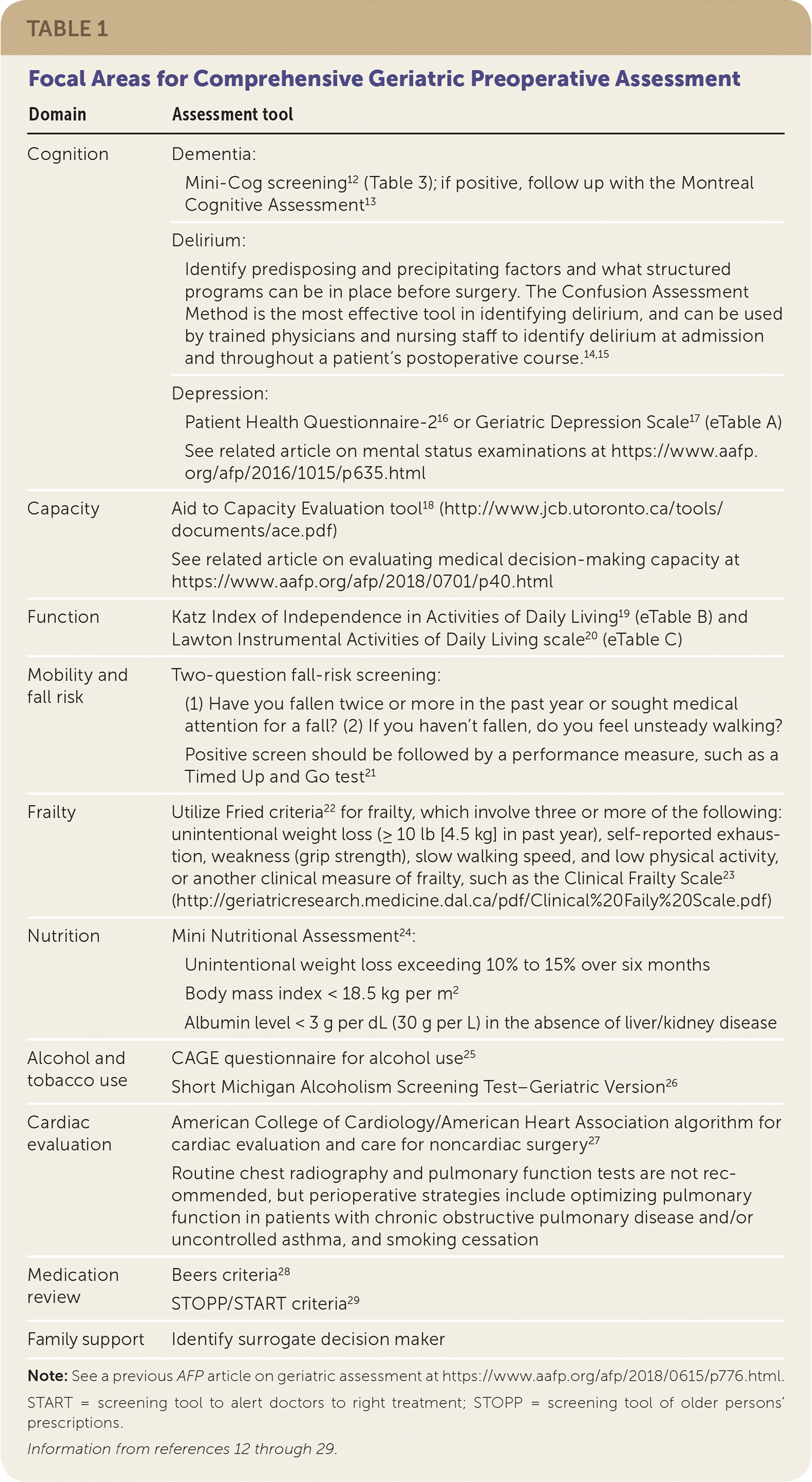
| Domain | Assessment tool |
|---|---|
|
|
| |
| |
|
|
| |
|
|
|
|
|
|
| |
|
|
| |
|
|
Geriatric Preoperative Assessment
COGNITION
Delirium, dementia, and depression are important considerations when evaluating cognition, because impaired sensorium has been shown to increase the risk of postoperative complications and mortality.30
Delirium is defined as an acute state of confusion and inattention, which may be accompanied by an altered level of consciousness and disorganized thinking. It is associated with poorer outcomes in the postoperative setting, including increased length of hospital stay, pulmonary complications, in-hospital falls, dehydration, and infections.31 The risk of developing delirium can be determined by assessing the number of predisposing and precipitating factors (Table 2).32 Targeting risk factors can reduce the occurrence and severity of delirium. For example, physicians can encourage family members to be at the patient's bedside, bring eyeglasses and hearing aids for those with vision or hearing impairment, and reorient often. Health care teams can promote early mobilization, early referral to physical and occupational therapy, adequate nutritional support and pain management, and minimization of patient tethers (e.g., Foley catheters, intravenous poles, electrocardiogram cords). The Confusion Assessment Method can help identify delirium in the perioperative period in high-risk patients.14 This method involves identifying key diagnostic criteria of delirium including (1) acute onset and fluctuating course, (2) inattention, (3) disorganized thinking, and (4) altered level of consciousness. The diagnosis of delirium using the Confusion Assessment Method requires the presence of the first two features plus either the third or fourth feature.
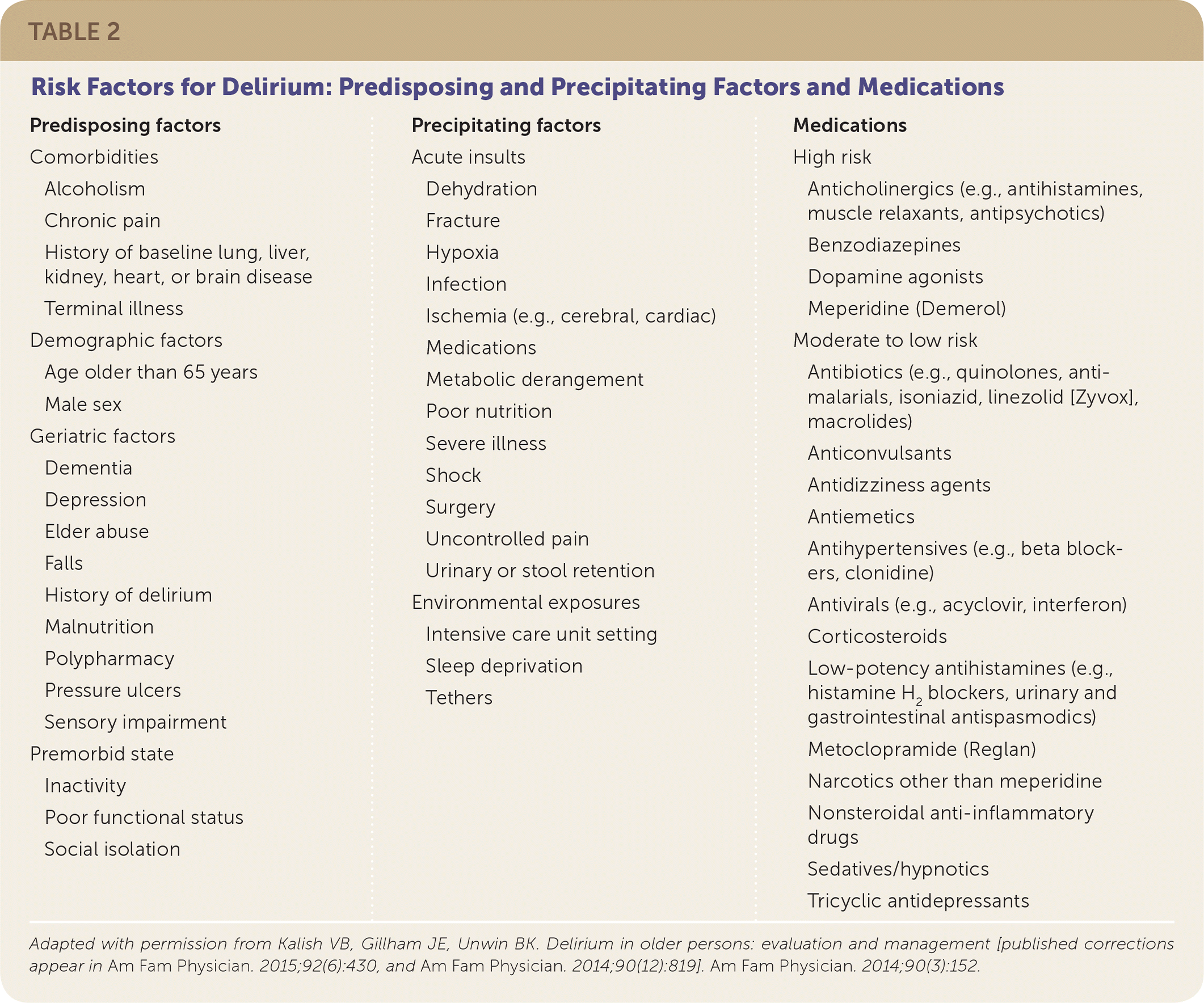
| Predisposing factors | Precipitating factors | Medications | |||
| Comorbidities | Acute insults | High risk | |||
| Alcoholism | Dehydration | Anticholinergics (e.g., antihistamines, muscle relaxants, antipsychotics) | |||
| Chronic pain | Fracture | Benzodiazepines | |||
| History of baseline lung, liver, kidney, heart, or brain disease | Hypoxia | Dopamine agonists | |||
| Terminal illness | Infection | Meperidine (Demerol) | |||
| Demographic factors | Medications | Moderate to low risk | |||
| Age older than 65 years | Metabolic derangement | Antibiotics (e.g., quinolones, antimalarials, isoniazid, linezolid [Zyvox], macrolides) | |||
| Male sex | Poor nutrition | Anticonvulsants | |||
| Geriatric factors | Severe illness | Antidizziness agents | |||
| Dementia | Shock | Antiemetics | |||
| Depression | Surgery | Antihypertensives (e.g., beta blockers, clonidine) | |||
| Elder abuse | Uncontrolled pain | Antivirals (e.g., acyclovir, interferon) | |||
| Corticosteroids | |||||
| Falls | Urinary or stool retention | Low-potency antihistamines (e.g., histamine H2 blockers, urinary and gastrointestinal antispasmodics) | |||
| History of delirium | Environmental exposures | Metoclopramide (Reglan) | |||
| Malnutrition | Intensive care unit setting | Narcotics other than meperidine | |||
| Polypharmacy | Sleep deprivation | Nonsteroidal anti-inflammatory drugs | |||
| Pressure ulcers | Tethers | Sedatives/hypnotics | |||
| Sensory impairment | Tricyclic antidepressants | ||||
| Premorbid state | |||||
| Inactivity | |||||
| Poor functional status | |||||
| Social isolation | |||||
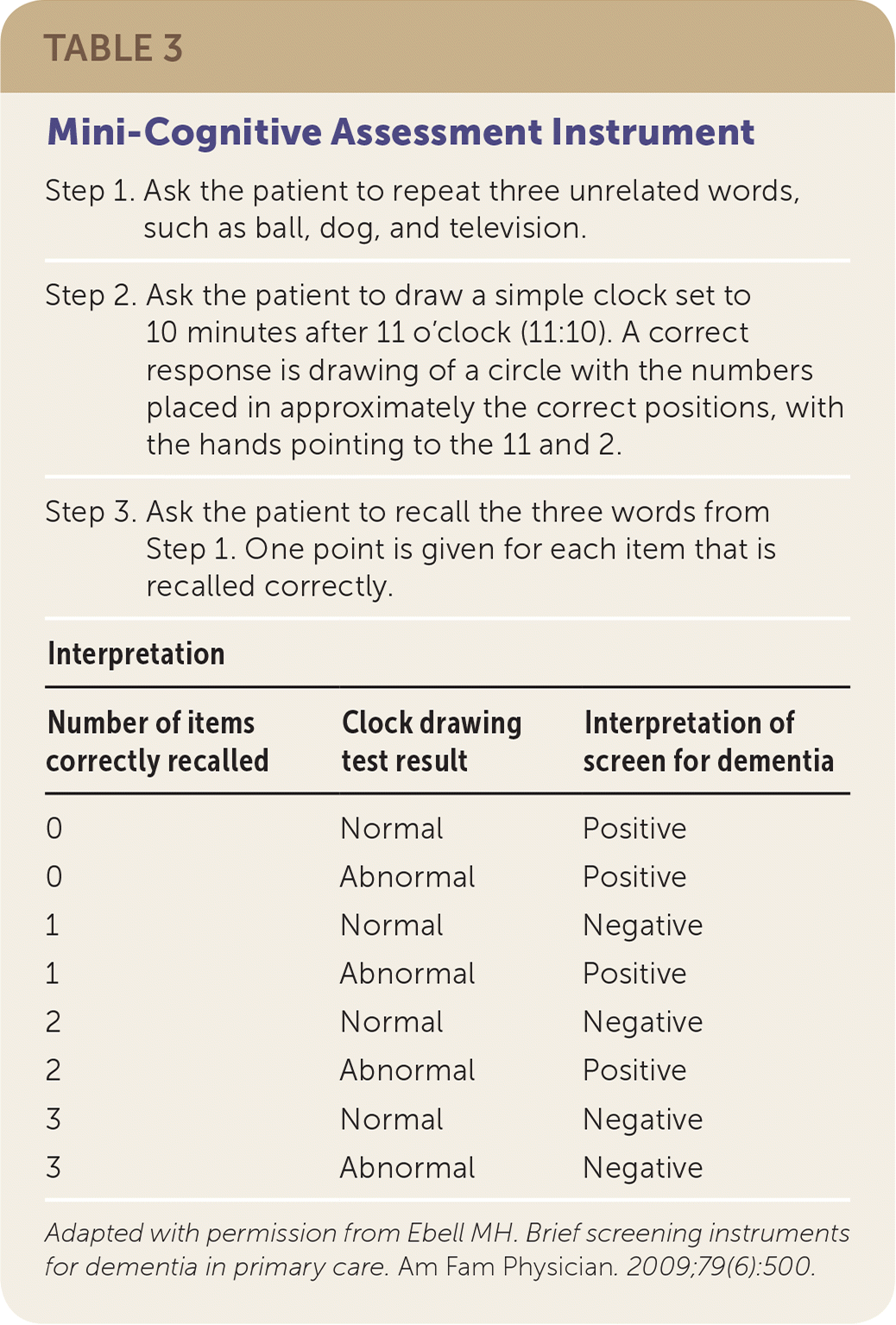
| Step 1. Ask the patient to repeat three unrelated words, such as ball, dog, and television. |
| Step 2. Ask the patient to draw a simple clock set to 10 minutes after 11 o'clock (11:10). A correct response is drawing of a circle with the numbers placed in approximately the correct positions, with the hands pointing to the 11 and 2. |
| Step 3. Ask the patient to recall the three words from Step 1. One point is given for each item that is recalled correctly. |
Depressive symptoms have also been associated with poor functional recovery and increased likelihood of discharge to a facility posthospitalization.34,35 Patients with preoperative depressive symptoms are more likely to develop and experience a longer duration of postoperative delirium.36 Screening for depression can be done using the Patient Health Questionnaire-216 or the Geriatric Depression Scale17 (eTable A; http://web.stanford.edu/~yesavage/GDS.html), both of which are brief, validated tools.
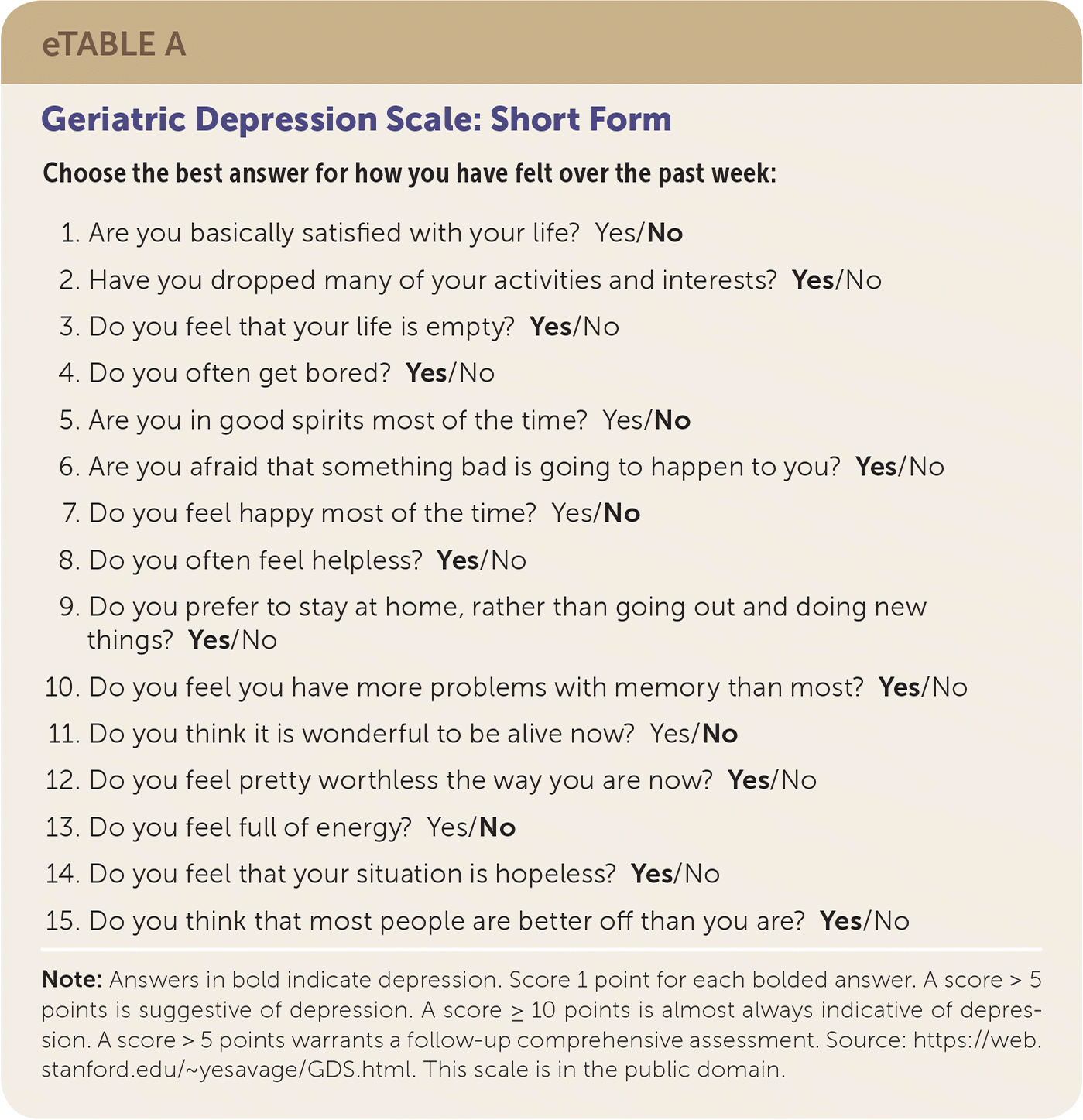
| Choose the best answer for how you have felt over the past week: |
| 1. Are you basically satisfied with your life? Yes/No |
| 2. Have you dropped many of your activities and interests? Yes/No |
| 3. Do you feel that your life is empty? Yes/No |
| 4. Do you often get bored? Yes/No |
| 5. Are you in good spirits most of the time? Yes/No |
| 6. Are you afraid that something bad is going to happen to you? Yes/No |
| 7. Do you feel happy most of the time? Yes/No |
| 8. Do you often feel helpless? Yes/No |
| 9. Do you prefer to stay at home, rather than going out and doing new things? Yes/No |
| 10. Do you feel you have more problems with memory than most? Yes/No |
| 11. Do you think it is wonderful to be alive now? Yes/No |
| 12. Do you feel pretty worthless the way you are now? Yes/No |
| 13. Do you feel full of energy? Yes/No |
| 14. Do you feel that your situation is hopeless? Yes/No |
| 15. Do you think that most people are better off than you are? Yes/No |
DECISION-MAKING CAPACITY ASSESSMENT
Assessing decision-making capacity is important, particularly if deficits are found on cognitive testing. Some patients lack capacity for specific periods of time, such as during critical illness, but not permanently. Patients with impaired capacity may still be able to make focused, less risky diagnostic and treatment decisions. The Aid to Capacity Evaluation is a useful tool that focuses on the specific decision the patient is facing and identifies the four elements of capacity: (1) understanding of the proposed treatment, (2) understanding of the risks, benefits, and alternative options, (3) ability to make a choice, and (4) ability to communicate the choice to the physicians.37 The Aid to Capacity Evaluation tool can be performed in less than 30 minutes and is available free online.18,38 For patients who lack capacity, a surrogate will need to assist with decision making and informed consent in the perioperative period.
FUNCTIONAL ASSESSMENT
Although many community-dwelling older adults are functionally independent, the percentage who need help performing activities of daily living doubles with each decade of age into the mid 80s.39 Functional status can be assessed using the Katz Index (eTable B) to assess activities of daily living19 and the Lawton scale (eTable C) to assess instrumental activities of daily living.20 Patients with functional impairment are at increased risk of postoperative complications, including functional decline and institutionalization.40
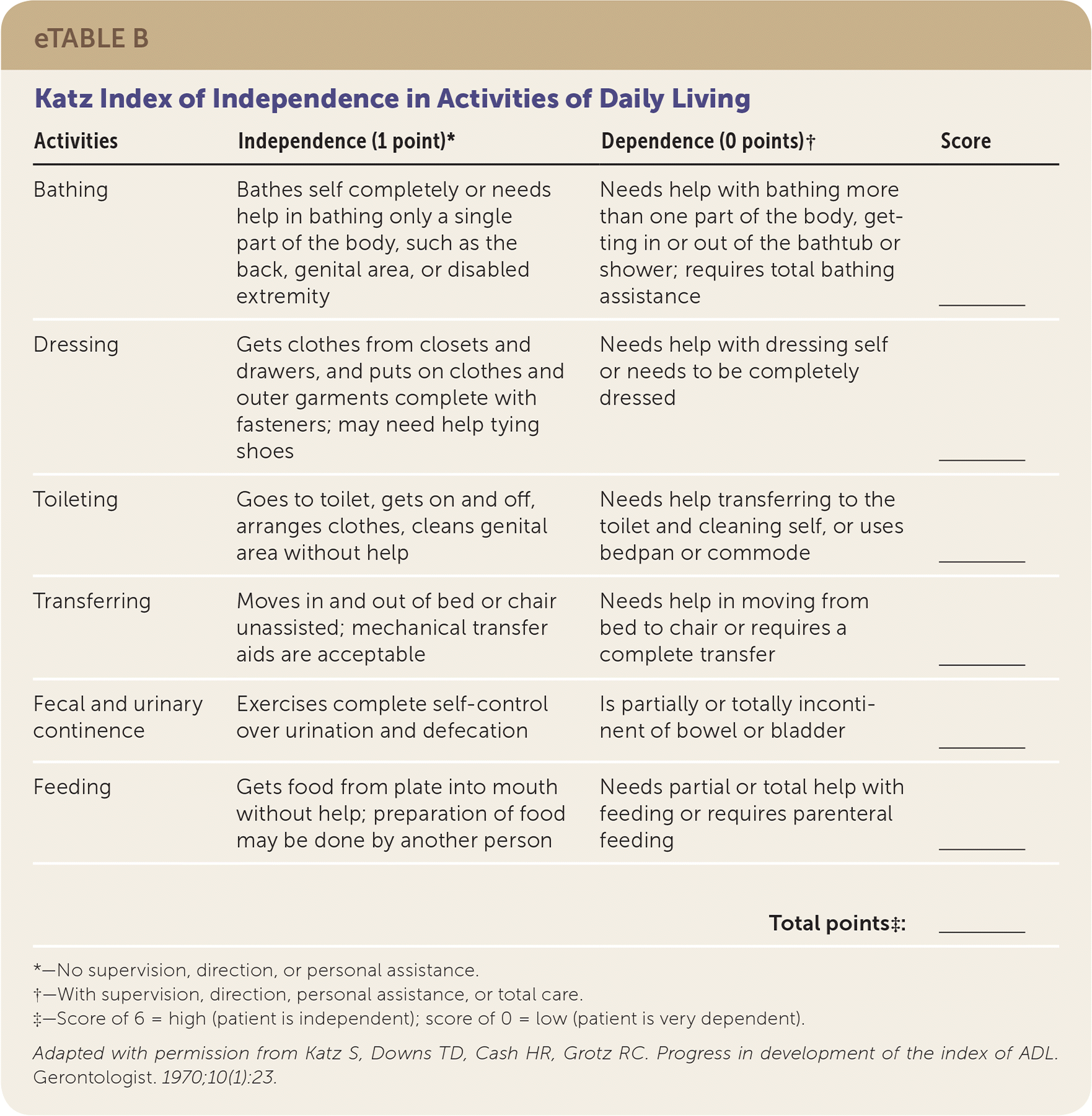
| Activities | Independence (1 point)* | Dependence (0 points)† | Score |
|---|---|---|---|
| Bathing | Bathes self completely or needs help in bathing only a single part of the body, such as the back, genital area, or disabled extremity | Needs help with bathing more than one part of the body, getting in or out of the bathtub or shower; requires total bathing assistance | _________ |
| Dressing | Gets clothes from closets and drawers, and puts on clothes and outer garments complete with fasteners; may need help tying shoes | Needs help with dressing self or needs to be completely dressed | _________ |
| Toileting | Goes to toilet, gets on and off, arranges clothes, cleans genital area without help | Needs help transferring to the toilet and cleaning self, or uses bedpan or commode | _________ |
| Transferring | Moves in and out of bed or chair unassisted; mechanical transfer aids are acceptable | Needs help in moving from bed to chair or requires a complete transfer | _________ |
| Fecal and urinary continence | Exercises complete self-control over urination and defecation | Is partially or totally incontinent of bowel or bladder | _________ |
| Feeding | Gets food from plate into mouth without help; preparation of food may be done by another person | Needs partial or total help with feeding or requires parenteral feeding | _________ |
| Total points‡: | _________ |
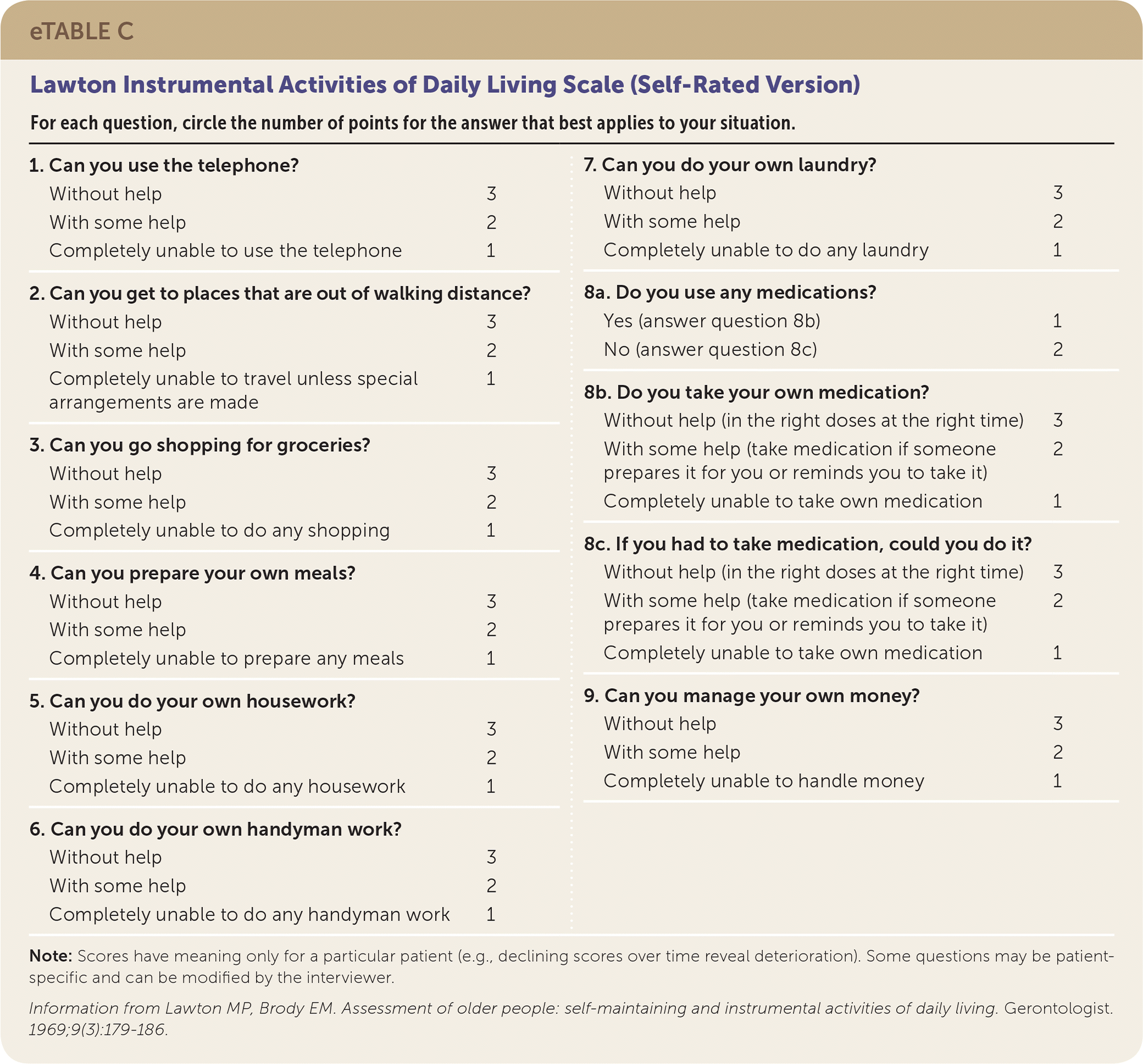
| For each question, circle the number of points for the answer that best applies to your situation. | |||||
|---|---|---|---|---|---|
| 1. Can you use the telephone? | 7. Can you do your own laundry? | ||||
| Without help | 3 | Without help | 3 | ||
| With some help | 2 | With some help | 2 | ||
| Completely unable to use the telephone | 1 | Completely unable to do any laundry | 1 | ||
| 2. Can you get to places that are out of walking distance? | 8a. Do you use any medications? | ||||
| Without help | 3 | Yes (answer question 8b) | 1 | ||
| With some help | 2 | No (answer question 8c) | 2 | ||
| Completely unable to travel unless special arrangements are made | 1 | ||||
| 3. Can you go shopping for groceries? | 8b. Do you take your own medication? | ||||
| Without help | 3 | Without help (in the right doses at the right time) | 3 | ||
| With some help | 2 | With some help (take medication if someone prepares it for you or reminds you to take it) | 2 | ||
| Completely unable to do any shopping | 1 | Completely unable to take own medication | 1 | ||
| 4. Can you prepare your own meals? | 8c. If you had to take medication, could you do it? | ||||
| Without help | 3 | Without help (in the right doses at the right time) | 3 | ||
| With some help | 2 | With some help (take medication if someone prepares it for you or reminds you to take it) | 2 | ||
| Completely unable to prepare any meals | 1 | Completely unable to take own medication | 1 | ||
| 5. Can you do your own housework? | 9. Can you manage your own money? | ||||
| Without help | 3 | Without help | 3 | ||
| With some help | 2 | With some help | 2 | ||
| Completely unable to do any housework | 1 | Completely unable to handle money | 1 | ||
| 6. Can you do your own handyman work? | |||||
| Without help | 3 | ||||
| With some help | 2 | ||||
| Completely unable to do any handyman work | 1 | ||||
Patients with functional deficits in their activities of daily living or difficulty with mobility should be referred to an occupational or physical therapist for further evaluation and preoperative therapy as appropriate. Prehabilitation involving multimodal approaches, including home exercise, nutrition assessment, relaxation techniques, and pain management, has been shown to improve postsurgical functional outcomes.41,42
MOBILITY AND FALLS
Falls are the primary cause of unintentional injury in older adults and a leading cause of death in this population. Mobility limitations are common in older adults and are associated with depression, social isolation, and decreased quality of life.43,44 Mobility limitations and falls lead to functional decline, hospitalization, institutionalization, and increased health care costs.43 In older adults undergoing surgery, a recent history of falls within the past 12 months is associated with increased postoperative complications, discharge to a rehabilitation facility, and high rates of hospital readmission.44 Fall risk can be assessed with measures such as the Timed Up and Go test.45 Strategies to reduce fall risk and improve mobility include exercise programs, physical therapy, and reducing medications associated with falls.4 These interventions can improve postoperative function, safety, and quality of life.46
FRAILTY
The physical phenotype of frailty is a clinical syndrome in which three or more of the following criteria are present: unintentional weight loss (10 lb [4.5 kg] in the past year), self-reported exhaustion, weakness (grip strength), slow walking speed, and low physical activity.22 There are several instruments to assess frailty, but, although comprehensive, they involve performance-based measurements that may be challenging in the outpatient clinic. If frailty is identified and time allows, interventions to reduce frailty before surgery may be tried.47 There are interventional studies on how best to do this, including vitamin D supplementation, protein supplementation, and exercise programs; however, general use of supplementation to treat frailty remains controversial. Increased levels of frailty may alert anesthesiologists to titrate fluid status and other physiologic parameters more narrowly than usual in the perioperative period.48
NUTRITION
Preoperative malnutrition has been shown to predict wound dehiscence, anastomotic leaks, infection, delirium, mortality, and increased length of hospital stay.4 The Mini Nutritional Assessment is the preoperative assessment tool with the greatest sensitivity and specificity.49 High-risk patients should be referred before elective surgery to a dietitian who can implement a perioperative nutritional supplementation plan.4
ALCOHOL AND TOBACCO USE
It is important to screen for alcohol use and notify surgical teams of the risk of alcohol withdrawal. Preoperative alcohol abuse and dependence are associated with increased rates of morbidity, postoperative complications, and prolonged hospitalizations.4,50 The most common screening tool is the CAGE questionnaire.25 Abstinence from alcohol is recommended four to eight weeks before surgery.51 Intensive preoperative alcohol cessation interventions, including pharmacologic strategies for relapse prophylaxis and withdrawal symptoms, may significantly reduce postoperative complication rates.51 Preoperative behavioral interventions may help reduce risky drinking, but their effectiveness and applicability to older adults are not clear.52
CARDIAC AND PULMONARY RISK
Cardiac risk evaluation is a central component of the preoperative surgical evaluation. Postoperative myocardial infarction is associated with significantly elevated in-hospital mortality rates. The American College of Cardiology and the American Heart Association have developed a guideline to assist physicians with evaluating cardiac risk before noncardiac surgery.27 The guideline recommends using preoperative cardiac testing judiciously, avoiding testing before low-risk surgeries, and ordering testing only if the results will change clinical management.
Postoperative pulmonary complications may prolong the hospital stay by one to two weeks and contribute to functional decline and increased morbidity and mortality. Risk factors for pulmonary complications include age older than 60 years, underlying lung disease, functional dependence, current smoking, delirium, weight loss, and surgical factors such as prolonged or emergency surgery, general anesthesia, and neuromuscular blockage.4
MEDICATION REVIEW
A complete review of a patient's medications, including over-the-counter medications, vitamins, and herbal supplements, is essential to identify medications that should be continued during the perioperative period as well as medications that may cause adverse effects, drug-drug interactions, or withdrawal.4 A medication review may uncover discrepancies between what patients are actually taking and what is listed on a medication list, and it provides an opportunity to remove medications that may be harmful or ineffective, or lack an indication. In one study, more than 50% of older patients undergoing surgery received a potentially inappropriate medication during their surgical hospitalization, underscoring the need to recognize and reduce potentially inappropriate medications in the perioperative period.55 There are multiple validated tools to assist in identifying potentially inappropriate medications among older adults, including the updated Beers criteria and the STOPP (screening tool of older persons' prescriptions) and START (screening tool to alert doctors to right treatment) criteria.28,29
Transition Planning
When included in a geriatric preoperative assessment, social support has been shown to predict 30-day postoperative morbidity.40 The American College of Surgeons/American Geriatrics Society guideline recommends that physicians assess patients' social support systems, because these are critical components of discharge planning.4 Primary care physicians should discuss postoperative plans with patients, including planning for recovery time, which may include a rehabilitation facility, home care, or additional support at home. The patient should be counseled about when to call the primary care physician after discharge, such as for medication reconciliation or a postoperative appointment to ensure a safe transition to home.
Editor's Note: For a previous AFP article on geriatric assessment, visit https://www.aafp.org/afp/2018/0615/p776.html. For a previous AFP article on evaluating medical decision-making capacity, visit https://www.aafp.org/afp/2018/0701/p40.html.
Data Sources: We performed a literature search using PubMed, the Cochrane Database of Systematic Reviews, evidence-based guidelines from the National Guideline Clearinghouse, the Institute for Clinical Systems Improvement, and the U.S. Preventive Services Task Force. Key words included preoperative care, geriatric assessment, and aged or aged 80 and over. Search dates: September 10, 2017, and February 21, 2018.
